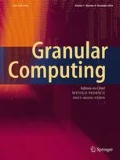Abstract
Pi Sigma artificial neural networks are a type of high-order neural network used in time series forecasting problems. In the Pi Sigma artificial neural networks, the weights between the hidden layer and the output layer are taken as constant and one, and the biases as constant and zero. Although this feature of the Pi Sigma artificial neural networks enables it to work with fewer parameters, it can also be seen as an obstacle to obtaining better forecasting performance. In this study, unlike classical Pi Sigma artificial neural networks, a modified Pi Sigma artificial neural network is proposed by taking the weights and biases as variables between the hidden layer and the output layer of the network. Thus, direct processing of the information coming to the output layer is prevented and the information coming to the output layer is weighted using different weights and bias values. The process of optimizing all the weights and bias values between the input and hidden layer, the hidden layer, and the output layer of the network is carried out together with the particle swarm optimization method. The proposed modified Pi Sigma artificial neural networks are compared with some other artificial neural networks in the literature by analyzing much well-known time series. As a result of the applications, it is seen that the forecasting performance of the modified Pi Sigma artificial neural networks is better than both the classical Pi Sigma artificial neural networks and many other artificial neural networks.

Similar content being viewed by others
References
Akdeniz E, Egrioglu E, Bas E, Yolcu U (2018) An ARMA type Pi Sigma artificial neural network for nonlinear time series forecasting. J Artif Intell Soft Comput 8:121–132
Akram U, Ghazali R, Mushtaq MF (2017) A comprehensive survey on Pi–Sigma neural network for time series prediction. J Telecommun Electron Comput Eng 9(3–3):57–62
Bas E, Grosan C, Egrioglu E, Yolcu U (2018) High order fuzzy time series method based on Pi–Sigma neural network. Eng Appl Artif Intell 72:350–356
Bas E, Egrioglu E, Kolemen E (2022) Training simple recurrent deep artificial neural network for forecasting using particle swarm optimization. Granul Comput 7(2):411–420
Chen SM, Kao PY (2013) TAIEX forecasting based on fuzzy time series, particle swarm optimization techniques and support vector machines. Inf Sci 247:62–71
Chen SM, Phuong BDH (2017) Fuzzy time series forecasting based on optimal partitions of intervals and optimal weighting vectors. Knowl Based Syst 118:204–216
Chen SM, Manalu GMT, Pan JS, Liu HC (2013) Fuzzy forecasting based on two-factors second-order fuzzy-trend logical relationship groups and particle swarm optimization techniques. IEEE Trans Cybern 43(3):1102–1117
Chen SM, Zou XY, Gunawan GC (2019) Fuzzy time series forecasting based on proportions of intervals and particle swarm optimization techniques. Inf Sci 500:127–139
Dash R, Routray A, Rautray R, Dash R (2018) Gold price prediction using an evolutionary Pi–Sigma neural network. Int J Eng Technol 7(4.5):742–746
Dash R, Rautray R, Dash R (2020) Utility of a shuffled differential evolution algorithm in designing of a Pi-Sigma neural network-based predictor model. Appl Computi Inform
Egrioglu E, Yolcu U, Bas E (2019) Intuitionistic high-order fuzzy time series forecasting method based on Pi–Sigma artificial neural networks trained by artificial bee colony. Granul Comput 4(4):639–654
Nayak J, Naik B, Behera HS (2015) A novel chemical reaction optimization based higher order neural network (CRO-HONN) for nonlinear classification. Ain Shams Eng J 6(3):1069–1091
Nayak J, Naik B, Behera HS (2014) A hybrid PSO-GA based Pi sigma neural network (PSNN) with standard back propagation gradient descent learning for classification. In: 2014 International conference on control, instrumentation, communication and computational technologies (ICCICCT), IEEE, pp 878–885
Nayak SC (2020) A fireworks algorithm based Pi-Sigma neural network (FWA-PSNN) for modelling and forecasting chaotic crude oil price time series. EAI Endorsed Trans Energy Web 7(28)
Nie Y, Deng W (2008) A hybrid genetic learning algorithm for Pi–Sigma neural network and the analysis of its convergence. In: 2008 Fourth international conference on natural computation, vol 3, IEEE, pp 19–23
Panda N, Majhi SK (2021) Oppositional salp swarm algorithm with mutation operator for global optimization and application in training higher order neural networks. Multimedia Tools Appl 1–25
Panda N, Majhi SK (2020) Improved spotted hyena optimizer with space transformational search for training Pi–Sigma higher order neural network. Comput Intell 36(1):320–350
Panigrahi S, Bhoi AK, Karali Y (2013) A modified differential evolution algorithm trained Pi–Sigma neural network for pattern classification. Int J Soft Comput Eng 3(5):133–136
Pant M, Kumar S (2021a) Fuzzy time series forecasting based on hesitant fuzzy sets, particle swarm optimization and support vector machine-based hybrid method. Granul Comput 1–19
Pant M, Kumar S (2021b) Particle swarm optimization and intuitionistic fuzzy set-based novel method for fuzzy time series forecasting. Granul Comput 1–19
Shin Y, Gosh J (1991) The Pi-Sigma network: an efficient higher order neural network for pattern classification and function approximation. In: Proceedings of the International Joint Conference on Neural Networks, Seattle, pp 13–18
Yılmaz O, Bas E, Egrioglu E (2021) The training of Pi–Sigma artificial neural networks with differential evolution algorithm for forecasting. Comput Econ 1–13
Yolcu U, Egrioglu E, Aladag CH (2013) A new linear and nonlinear artificial neural network model for time series forecasting. Decis Support Syst 1340–134
Yu X, Deng F, Tang LX (2011) Training Pi–Sigma neural network by stochastic simple point online gradient algorithm with Lagrange multiplier method. Appl Res Comput 11
Zhao L, Yang Y (2009) PSO-based single multiplicative neuron model for time series prediction. Expert Syst Appl 36:2805–2812
Author information
Authors and Affiliations
Corresponding author
Ethics declarations
Conflict of interest
The author declares that there is no conflict of interest toward the publication of this manuscript.
Additional information
Publisher's Note
Springer Nature remains neutral with regard to jurisdictional claims in published maps and institutional affiliations.
Rights and permissions
About this article
Cite this article
Egrioglu, E., Bas, E. Modified Pi Sigma artificial neural networks for forecasting. Granul. Comput. 8, 131–135 (2023). https://doi.org/10.1007/s41066-022-00320-7
Received:
Accepted:
Published:
Issue Date:
DOI: https://doi.org/10.1007/s41066-022-00320-7




